How to Draw Cartoon Dogs
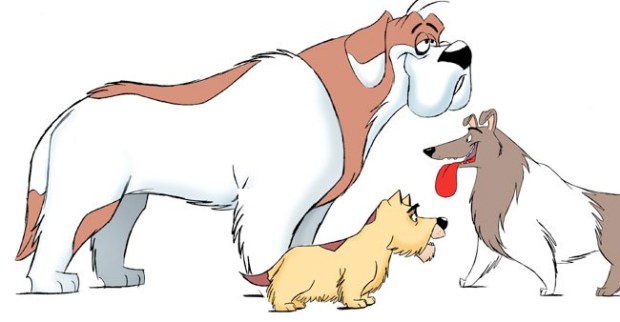
Dogs and puppies are immensely popular in comic strips and animation. The cartoonist who can draw convincing dogs has a leg up on the competition.
With the following tips, you can, too. So sharpen that pencil, get out some paper and let’s get started.
DRAWING THE HEAD
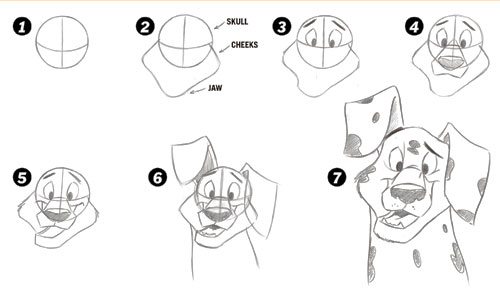
All dogs share the same basic head and body construction. By practicing these steps, you’ll soon be able to draw any dog. (Don’t trace. You’ll learn much more if you freehand.)
Let’s start with a dalmation.
Step 1: Begin with a circle. Drawing the guidelines on the circle will help you see it as a three-dimensional globe. The horizontal line hangs low on the globe — that’s where the eyes will go. The vertical line is the center line — it divides the face in half.
Step 2: The head has three components: the skull, the cheeks and the jaw.
Step 3: Place the eyes on the horizontal “eye line.”
Step 4: The bridge of the nose begins high on the face — between the dog’s eyes — and thrusts forward. Notice how it gets larger as it comes toward you.
Step 5: Now add a smiling mouth, which pushes up into the cheeks and causes creases. The jaw, off to one side, creates a lively smile.
Step 6: Big, floppy ears and a thick neck bring this guy to life. A few small teeth on the lower jaw add a professional touch.
Step 7: Add spots, and erase your guide lines for a clean finished drawing.
THE EARS

Floppy ears add charm and personality to a dog. Most dog ears fold over, with the exception of short, triangular ears — the kind found on terriers, chow chows, German shepherds and a few other breeds. The most important thing to remember about drawing the folded ear is that the line from the base of the ear should point to the outermost corner of the fold.
Right: The base of the ear points to the outermost corner of the fold. (The dashes are not part of your drawing.)
Wrong: The base of the ear doesn’t connect to anything; it just shoots out into space.
DRAWING THE BODY-SIDE VIEW
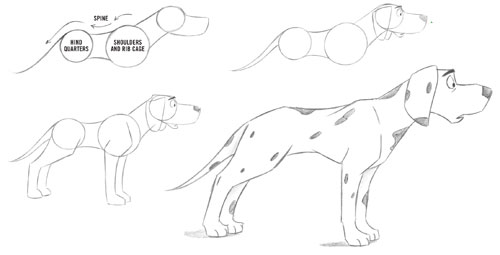
There are three main parts to a dog’s body: the head, the rib cage and the hindquarters. Everything connects to those three areas. Notice how the back crests at the base of the neck. The large rib cage gives the dog a powerful chest. The hindquarters rise, although slightly less than the shoulders, and then slope down sharply toward the tail. The tail is an extension of the spine and must flow seamlessly from the spinal cord.
CLASSIC TERRIER

The tiny terrier’s neck is surprisingly thick and muscular. The compact body shows very little in the way of a waistline, and the short legs allow the body to hover just above the ground. Note the distinctive triangular ears. He’s also got bushy eyebrows, a bushy mouth, bushy forelegs and hind legs, and small paws.
COLLIE
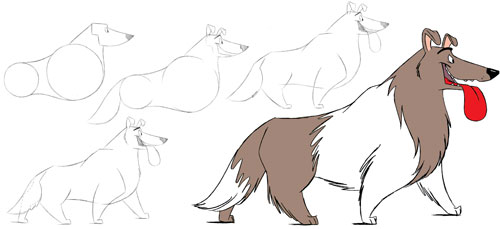
This breed has a slender, almost pointed face and an appealing two-toned coat of fur. It always maintains an alert expression and gives the impression of being a large dog. However, under that huge layer of hair is a rather trim animal with an unimpressive build. The small paws are the giveaway.
But, because our view of the collie as a full-bodied dog is so ingrained in us, it’s better to start with an overall large shape than to draw a thin body and fill it out with hair. The collie is always well-groomed, so don’t let the hair appear ragged.
SAINT BERNARD
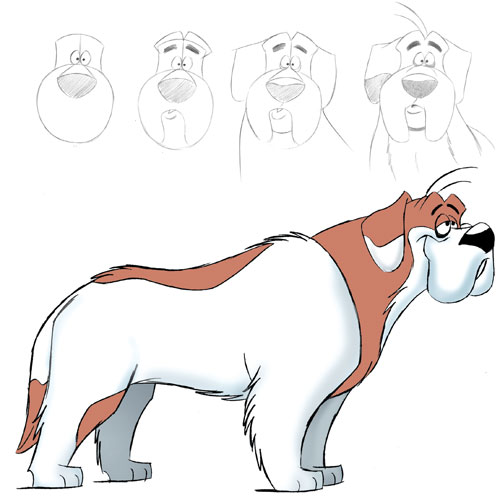
The Saint Bernard is instantly recognizable for its long, flapping jowls. It’s not a graceful dog; in fact, its movements are kind of, well, sloppy. It should always appear to be well fed, and it has a sort of dopey personality. Give your Saint Bernard a big nose. The ears are actually shorter than shown here, but cartoons typically depict this dog with long ears.
CREATING EXPRESSIONS
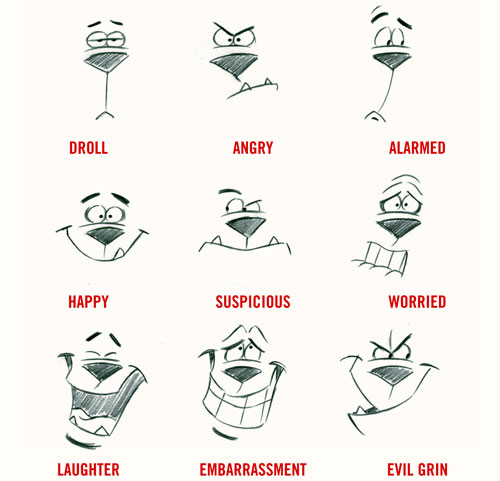
Most people only think to use the mouth and the eyebrows to create facial expressions, but there’s more to it than that. The shape of the eyes changes, depending on whether the eyebrows crush down on the eyes or lift them up.
Most importantly, though, is the length of the upper lip, which changes according to the expression. Notice how short the upper lip is in the happy expressions here and how long it becomes in surprised or unhappy expressions. The mouth can be “tugged” to one side, which provides an extra accent.
You can add teeth or forget about them, depending on the emotion being expressed, and you can even change the shape of the teeth. Spiked teeth work well in angry expressions but not on worried ones — they look too aggressive.
LINE OF ACTION
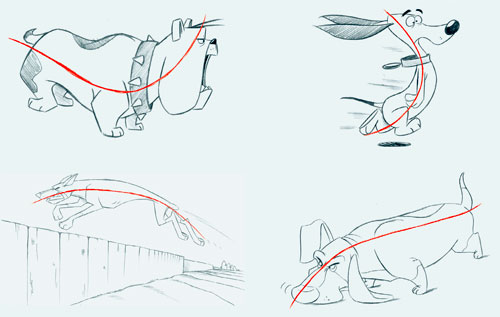
When I look at the sketchbooks of aspiring cartoonists and artists, most illustrations don’t convey a sense of thrust. The artists have worked hard on the eyes, the head, the muscles and so on, but there is no flow to the drawings. They have no direction. The characters are just jumbles of parts, which makes them look stiff. It’s certainly important to master drawing those individual parts. No doubt about it. But the parts need an overall framework in which to exist. That’s where the line of action — shown in red — comes into play.
LEARN MORE
To learn more about drawing dogs and other animals, check out Christopher Hart’s book, You Can Draw Cartoon Animals.
Just what I was looking for! I needed to draw a dog mascot for a Peruvian Scout group (where I’ve been a Scoutmaster). Got the basics and it’s very helpful… Thanks!
I was looking for a dog to advertise my classes, I found it. Thanks
really nice info here
learned a lot! Keep it up!
by the way-put on english setters!!!
what’s against labs?
This is awsome,ive learned alot since I went to this website.I love it,I just do.
Hey, What about a German Shepherd! I love those thing’s! There one of the world’s smartest dog in the world.
What about Chihuahuas?
Cool I’m going to get a piece of paper now!!
very useful for novice AND expert drawers. good tips:)
ASWOME